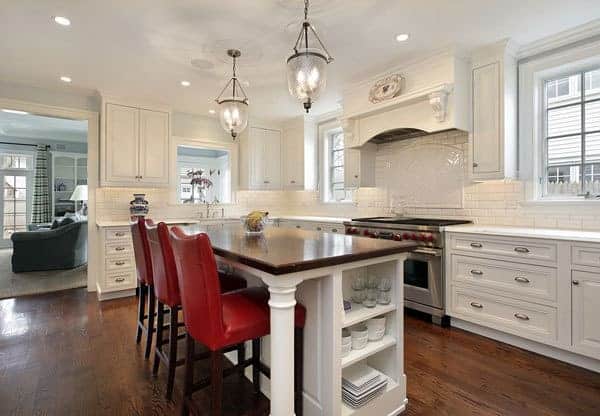 Kitchen lighting isn't the first thing you think about when you're planning a kitchen remodeling project. Except for the light fixture(s) over the kitchen island, you've probably never noticed your kitchen lighting until a bulb burns out. Or if the kitchen design wasn't done right, you might be frustrated that there's never enough light for what you're doing.
Kitchen lighting isn't the first thing you think about when you're planning a kitchen remodeling project. Except for the light fixture(s) over the kitchen island, you've probably never noticed your kitchen lighting until a bulb burns out. Or if the kitchen design wasn't done right, you might be frustrated that there's never enough light for what you're doing.
As you'll spend many hours in your kitchen, even if you don't cook much (my husband is the cook in our home), you should try to include lots of natural sunlight in your kitchen design. When remodeling my kitchen (pictured above), the goal was to maximize sunlight so we added clerestory windows to capture the early morning sun. We used recessed ceiling lights (called cans) plus task lighting under the wall cabinets spot (see more photos of my remodeled kitchen).
 The Different Types of Kitchen Lighting
The Different Types of Kitchen Lighting
The most common mistake made with kitchen lighting is a single light fixture on the ceiling to light the entire room. It simply doesn't work as some parts of the kitchen have too much light, and other areas have too light light or shadows.
Another popular kitchen light design uses recessed lights in some type of grid configuration. While the goal is to insure there's enough light anywhere in the room, you're likely to still find work areas where you don't have enough light.
So what kind of kitchen lighting do you need? You need several different types of lighting that work together. Here are the four different types of lights recommended for every kitchen.
- Ambient or general lighting – is the light you rely on when you walk into the kitchen. It creates a warm glow and welcomes you into the kitchen. You can use a ceiling light fixture, recessed lights or track lighting for your ambient kitchen lighting.
- Task lighting – helps you with specific tasks like reading recipes, chopping vegetables or rolling out cookie dough. Ideally task lighting should be positioned so it comes between a person's head and the work surface. Under cabinet lighting is a popular solution for this lighting, and don't forget to include task lighting in your pantry.
- Accent lighting – creates visual interest in the kitchen, drawing your eye to special features you want to highlight. Examples of accent lighting are light ropes placed inside glass-front kitchen cabinets and low-voltage fixtures that spotlight a collection of glassware, a favorite painting or even plants.
 Adding Kitchen Lighting to Your Kitchen Design
Adding Kitchen Lighting to Your Kitchen Design
Now it's time to pick your lighting fixtures. Here are the most common ones used for kitchen lighting, and then we'll show you some new designs which are redefining your lighting options. A new challenge for kitchen lighting stems from open floor plan, where you'll want to coordinate fixtures used in rooms that are now open to each other.
- Ceiling fixtures – are popular for ambient kitchen lighting. These can involve a single fixture or multiple pendants hanging down from a central ceiling mount.
- Recessed lighting – is also very popular in kitchens as you can place them for various activities, and they don't take up visual space.
- Track or rail lighting – allows for multiple light fixtures to be hung from the ceiling, with flexibility so you can direct the light where you want it. Rail lighting is similar to track light, with the added benefit of the ceiling track being bendable.
- Under cabinet fixtures – as the name implies, are installed underneath your wall cabinets.
- Over cabinet lighting – is similar to under cabinet lighting, with the lights installed on top of your kitchen wall cabinets.


 The Different Types of Kitchen Lighting
The Different Types of Kitchen Lighting Adding Kitchen Lighting to Your Kitchen Design
Adding Kitchen Lighting to Your Kitchen Design



Leave a Reply